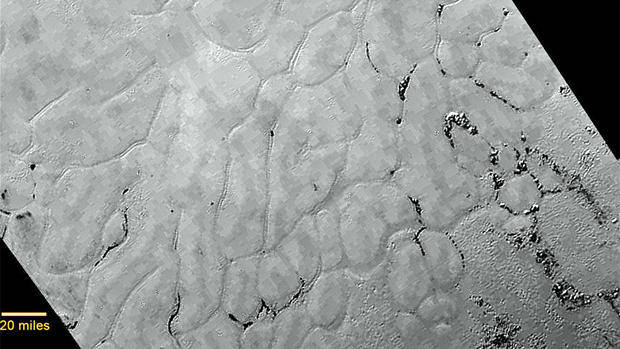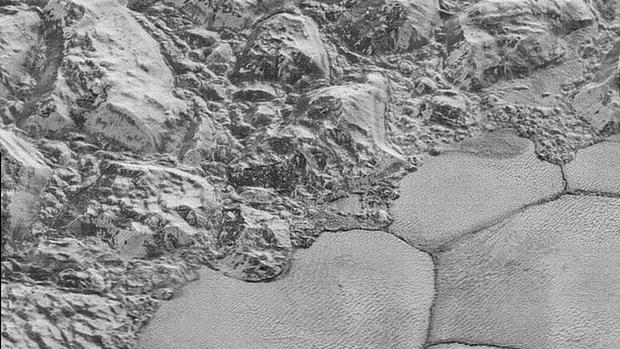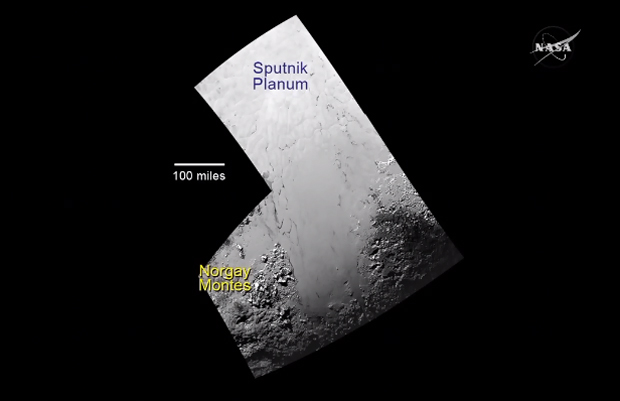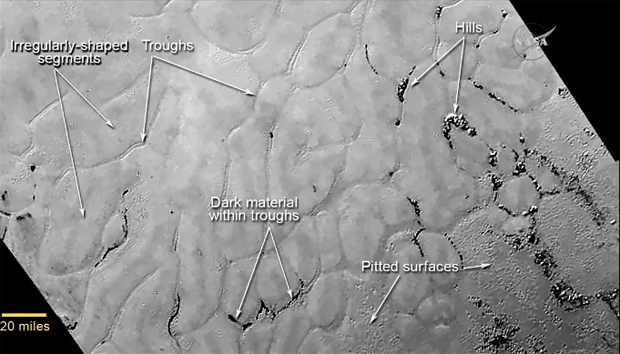New Horizons zooms in on frozen "heart" of Pluto
New images of Pluto snapped by the New Horizons probe as it flew past the dwarf planet Tuesday show that a vast heart-shaped region now known as Tombaugh Regio is actually a crater-less plain made up of irregularly shaped ice blocks, or polygons, that are bordered by shallow trench-like depressions, scientists said Friday.
Other features visible in the new image include countless small pits, or depressions, possibly caused by surface ice sublimating, or changing directly into a gas, into Pluto's tenuous nitrogen atmosphere and what appear to be clumps of low hills of unknown origin.
Equally mystifying, some of the troughs, or trench-like channels bordering the icy plates making up the Tombaugh plain, named after Pluto-discoverer Clyde Tombaugh, appear much darker, possibly indicating a different material that was either deposited there or somehow "erupted" from below.
Other intriguing findings unveiled Friday: Pluto's tenuous nitrogen atmosphere extends 1,000 miles into space and is being lost at a rate of 500 tons per hour thanks to the dwarf planet's low gravity and interactions with the solar wind.
Equally intriguing, measurements show high concentrations of carbon monoxide ice centered in the heart of Tombaugh Regio. It is not yet known how thick the ice might be, whether is somehow welled up from the dwarf planet's interior or whether it was deposited on the surface in some other fashion.
And dark streaks, or smudges spotted on the surface that appear to be oriented in the same direction could be the results of wind blowing across the ultra-cold surface.
"Have a look at the icy, frozen plains of Pluto," New Horizons principal investigator Alan Stern marveled. "Who would have expected this kind of complexity?"
The new image shows terrain adjacent to a region revealed Wednesday that features towering 11,000-foot-tall mountains of water ice. That region is now known as Norgay Montes after Tenzing Norgay, the Nepalese sherpa who accompanied Edmund Hillary to the top of Mt. Everest in 1953.
The frozen plains inside Tombaugh Regio -- the so-called "heart of Pluto" -- have been named Sputnik Planum after the first artificial satellite.
Jeffrey Moore, a co-investigator at NASA's Ames Research Center, said the frozen landscape revealed by New Horizons "is just astoundingly amazing."
"The global view shows some surfaces of Pluto are peppered with impact craters and are therefore relatively ancient, perhaps several billion years old, whereas other regions, such as the interior of (Tombaugh Regio) show no craters at all and are thus obviously younger.
"So this means there are active landform-creating processes operating into the geologically current time," Moore said. "Some craters appear partially destroyed, perhaps by erosion, and there are also hints of parts of Pluto's crust that have been fractured, and thus that indicates there's probably been some forms of tectonics."
Sputnik Planum, with its irregular blocks and trenches is "not easy to explain terrain," Moore quipped.
"You can clearly see we've discovered a vast crater-less plain with some strange story to tell," he said. "Judging from the absence of impact craters, it's clear that Sputnik Planum couldn't possibly be more than, let's pick a round number, a 100 million years old, and is possibly still being shaped to this day by geological processes."
The darker material in some of the troughs bordering the irregular plates may be "collected there or erupted there, I don't know," Moore said.
"Much more enigmatic are these clusters of hills in the upper right of the frame," he added. "They appear to be elongated clumps, or mounds, and they trace out the shapes of the troughs that encircle the polygons."
The hills may have been pushed up from below along cracks in Pluto's crust. But it's also possible "they are erosion resistant knobs that are standing out as the surface is getting massively eroded and lowered," Moore said. "We don't know which of those two explanations are correct."
And what might have caused the irregular shapes, or polygons, in the first place?
"One possibility out of many is that the polygons are signs of convection occurring within a surface layer of carbon monoxide, methane and nitrogen ice driven by the modest heat from the interior of Pluto itself, creating kind of the same sorts of patterns you see when you look at the surface of a boiling pot of oatmeal, or like the blobs in a lava lamp," Moore said.
"Alternatively, these polygons could be analogous to mud cracks, and they could be created by the contraction of the surface materials."
New Horizons passed by Pluto early Tuesday. As of Friday afternoon, it was more than two million miles beyond the dwarf planet and sailing deeper into space at some 31,000 miles every hour.
Stern said only a tiny fraction of the data stored on New Horizons' solid-stage recorders have been transmitted to Earth and that more images will be released next week. It will take 16 months to phone home all of the spacecraft's recorded data.
But Stern said the spacecraft "is doing very well" and "operating according to plan."
"I'll have to tell you, I'm a little biased," he said, "but I think the solar system saved the best for last."




